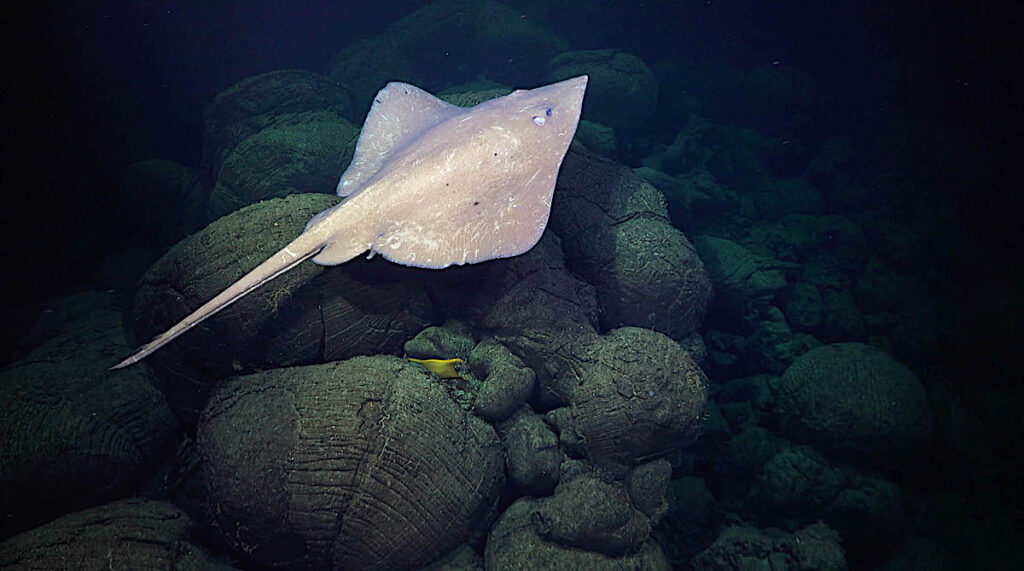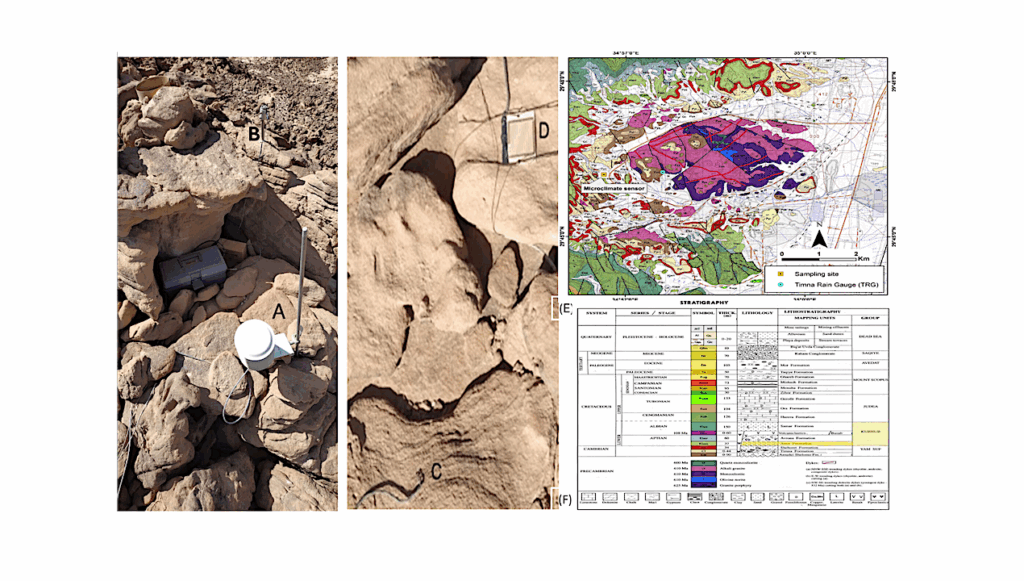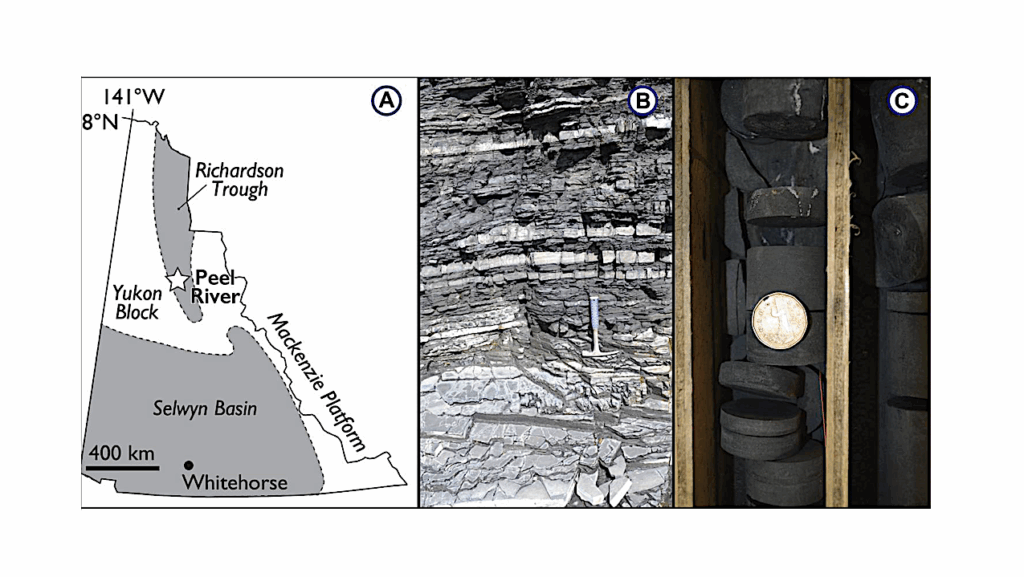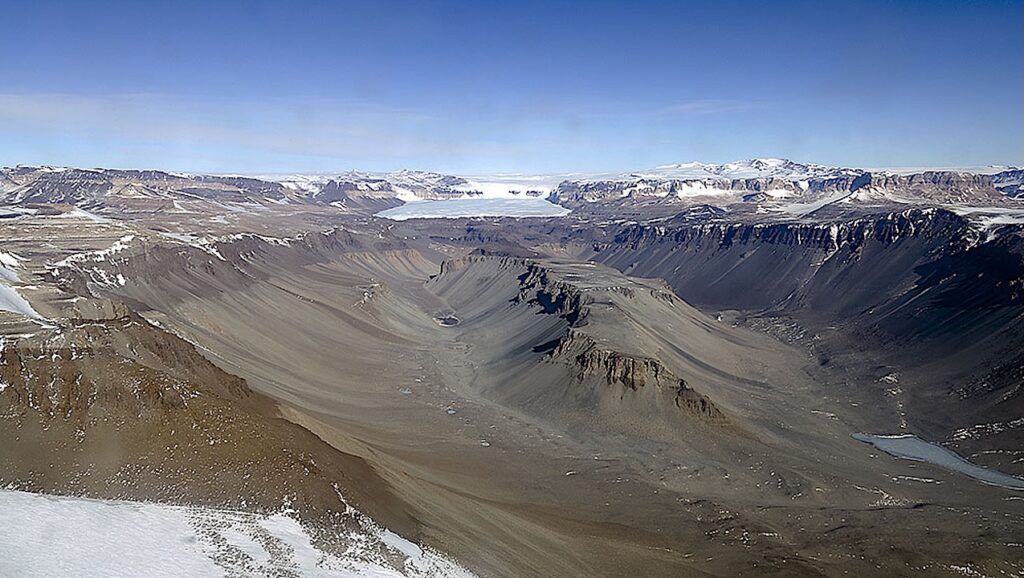Away Team Report: Scientists Locate New Hydrothermal Vent Field Using State-of-the-Art Mapping Technology

An international research team has discovered a new high-temperature hydrothermal vent field that hosts several 10- to 15-meter-tall actively venting chimney clusters. Scientists located the vent field in the Pacific Ocean off the Western Galápagos Islands utilizing state-of-the-art mapping technologies not often used in scientific exploration.
An international research team aboard Schmidt Ocean Institute’s research vessel Falkor (too), have discovered a new high-temperature hydrothermal vent field that hosts several 10- to 15-meter-tall actively venting chimney clusters. The vent field, named “Tortugas” by the science team and Ecuadorian observers, stretches more than 600 meters along the western edge of the caldera floor of the Los Huellos East submarine volcano.

A skate swims above an egg pouch (small yellow case in rocks). They also examined a Pacific White Skate nursery on low-temperature hydrothermal vents. The Galápagos Pacific White Skate nursery is one of two confirmed nurseries in the world, the other is located in Canada. Larger image — Schmidt Ocean Institute
Scientists detected the vent field in the Pacific Ocean, off the Western Galápagos Islands, utilizing state-of-the-art mapping technologies not often used in scientific exploration. The discovery marks the second hydrothermal vent field in the Ocean around the Galapagos Islands found by scientific teams on board the Schmidt Ocean Institute expedition this year.
During the expedition, led by Dr. John Jamieson of Memorial University of Newfoundland, Canada, researchers attached two high-resolution mapping technologies to an ROV; an M3 Sonar and Interferometric Synthetic Aperture Sonar (InSAS). The technologies were used in tandem to create highly detailed seafloor maps with up to 3-centimeter resolution. For comparison, the best shipboard sonar technologies create maps with 15- to 50-meter resolution in water depths of 1.5 to 3 kilometers.
The finely detailed maps allowed scientists to locate new hydrothermal vents surrounding the Galápagos, characterize the chemicals they emit, and the animals that live on them. Fifteen species not previously known to live in the region were located by the science team, including a “living fossil” mollusc known as a monoplacophoran. They also examined a Pacific White Skate nursery which exists on low-temperature hydrothermal vents. The Galápagos Pacific White Skate nursery is one of two confirmed Pacific White Skate nurseries in the world, the other is located in Canada.
The science team used the technologies to also revisit the world’s first discovered hydrothermal vent field, known as Rose Garden, which was found in 1977. A 2002 expedition to the site onboard Woods Hole Oceanographic Institution’s R/V Atlantis determined that Rose Garden is no longer active, after it was paved over by lava from a volcanic eruption. A subsequent expedition with the E/V Nautilus in 2015 visited the site and discovered evidence of low-temperature venting, but did not locate the source. With the help of newly acquired detailed maps and acoustic images of this site, the team were able to produce the first full picture of this historic vent field and identify specific features associated with the hydrothermal evolution of this site since its discovery.

InSAS image of lava flows (pillow basalts and lobate flows) from the floor of the Los Huellos East caldera. Larger image — Schmidt Ocean Institute
Inactive hydrothermal vents are a potential target for seafloor mining and the data collected from the expedition will aid scientists in understanding the role inactive vents play for the planet and the animal communities that live on them. Ecuador has called for a precautionary pause on deep-sea mining.
“We returned to the site where hydrothermal venting was first discovered with technology that the original explorers never dreamed of,” said Jamieson. “This technology is revolutionizing our ability to explore and characterize these sites in a manner not imaginable in the late 1970s. It is the ocean equivalent of returning to the moon after fifty years but with the latest 21st century technology.”
The use of high-resolution maps and images not only helped identify venting sites that were previously known to be active and had not been explored before, but also led to new discoveries in sites that had been previously studied. The maps and samples from the expedition will aid scientists in creating a more complete picture on the lifecycle of hydrothermal vent ecosystems.
Inactive hydrothermal vents are a potential target for seafloor mining and the data collected from the expedition will aid scientists in understanding the role inactive vents play for the planet and the animal communities that live on them. Ecuador has called for a precautionary pause on deep-sea mining.

Hydrothermal vent ecosystem life, including tube worms, fish, bivalves. An international research team has discovered a new high-temperature hydrothermal vent field that hosts several 10- to 15-meter-tall actively venting chimney clusters. Scientists located the vent field in the Pacific Ocean off the Western Galápagos Islands utilizing state-of-the-art mapping technologies not often used in scientific exploration. Larger image — Schmidt Ocean Institute
“These finely detailed maps created with state-of-the-art technology are exceptional for the area they cover and the seafloor complexity they reveal,” said Schmidt Ocean Institute’s executive director, Dr. Jyotika Virmani. “In addition to increasing the scientific knowledge of the region, it is wonderful to know they will be used in Ecuador’s management of their own marine resources. Schmidt Ocean Institute is committed to stewarding new technologies that allow us to fully map and characterize the seafloor.”
The 30-day expedition began on 24 October 2023 in collaboration with the Galápagos National Park Directorate (GNPD), Charles Darwin Foundation, and the Ecuadorian Navy’s Oceanographic and Antarctic Institute (INOCAR). Other participating institutions included Memorial University of Newfoundland, University of Victoria, Dalhousie University, University of Ottawa, The Japan Agency for Marine-Earth Science and Technology, The United States Geological Survey, University of Quebec at Romouski, Kraken Robotics, and Fisheries and Oceans Canada.
About the Organizations
Schmidt Ocean Institute was established in 2009 by Eric and Wendy Schmidt to catalyze the discoveries needed to understand our ocean, sustain life, and ensure the health of our planet through the pursuit of impactful scientific research and intelligent observation, technological advancement, open sharing of information, and public engagement, all at the highest levels of international excellence. For more information, visit www.schmidtocean.org.
The Galapagos National Park Directorate is responsible for conserving the ecological health and biodiversity of the insular and marine ecosystems of the protected areas. They also ensure the rational use of goods and services that the protected areas generate for the community.
Since 1959, the Charles Darwin Foundation has worked in close partnership with the Galápagos National Park Directorate to protect the Islands’ natural resources and share scientific results for the conservation of this living laboratory. More than one hundred scientists, educators, researchers, support personnel and volunteers from all over the world have participated in this effort. Currently, more than 75% of the staff are Ecuadorian citizens. The Charles Darwin Foundation is committed to the professional development of permanent Galápagos residents as future scientists, for the well-being of the islands and the nation in general. For more information visit: www.darwinfoundation.org
Instituto Oceanográfico y Antártico de la Armada (INOCAR) is a technical body of the National Maritime Authority of Ecuador and serves as the National Hydrographic Service. It performs several functions related to hydrography and marine navigation, including hydrographic surveying, chart production, maintenance of aids to navigation, oceanic condition monitoring, provision of weather forecasts, and issuance of tsunami alerts. INOCAR also plays a pivotal role in controlling and monitoring oceanographic exploration and research activities to ensure their effective execution and alignment with national regulations. For more information visit: www.inocar.mil.ec
Memorial University of Newfoundland is one of Canada’s premier centres for ocean related research, and one of Canada’s top-20 research universities. Memorial is a partner with the Ocean Frontier Institute, a $220 million collaborative research initiative aimed at harnessing the vast potential of the world’s ocean. Memorial is also part of Canada’s Ocean Supercluster, a private sector-led partnership using innovation and commercialization to drive increased sustainable economic growth from our oceans.
Astrobiology








